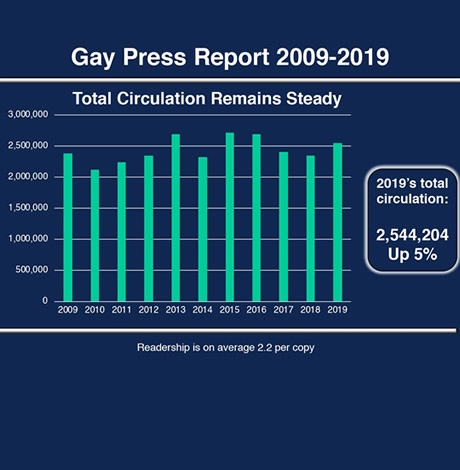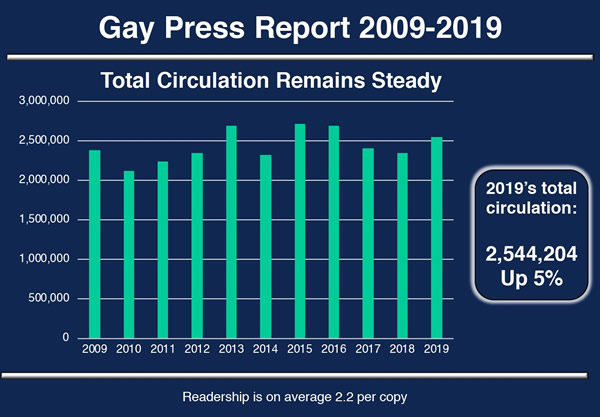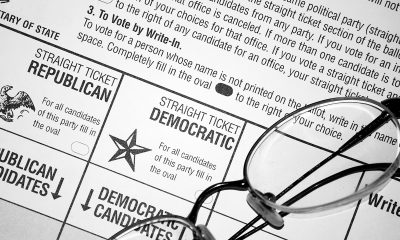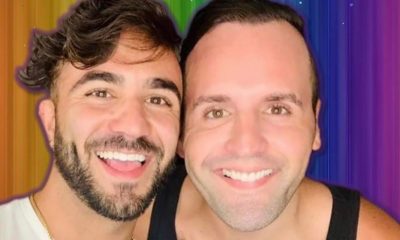Financial
LGBT press to advertisers: Don’t cut print
Experts warn companies not to show up at Pride, then disappear


Despite the paradigm shift declared by the Buggles during the debut moments of MTV, video didn’t kill the radio star—no more than the emergence of digital dealt a fatal blow to newsprint. But it did put another arrow in the quiver of advertisers, and gave readers a dizzying array of new destinations.
So with a world of news, information, and (we’ve heard) porn available on the phone you carry or the computer you use, why would the LGBT consumer choose to go the page-turning route?
“Well, I think the main thing is trust,” says Pride Source Media Group CFO Jan Stevenson. Along with her wife, Susan Horowitz, they publish Between The Lines, Michigan’s weekly LGBT newspaper.
“The LGBT print press,” says Stevenson, “has a certain level of quality and professionalism. We’re steeped in the ethics that center around publishing, that blogs and online sites just don’t have. It’s been vetted, and there are reputable people standing behind the work.”
Concurring on the matter of credibility is Scott Seitz, who says, “I absolutely believe in digital, but I do believe that digital often does not have the same integrity as print.”
Seitz, whose SPI Marketing LLC counts Absolut Vodka among its clients, notes, “When you have a team of people slapping together a meme or a statement, they’re just checking boxes.”
As a result, says Seitz, “It becomes less and less meaningful. It’s more about, ‘What can I do today to get attention?’ People are doing mechanical stuff, and those people are not necessarily from the [LGBTQ+] community… It’s not being done with a high level of integrity or seriousness.”
Like the connection forged at a mom-and-pop shop that can’t be bought by shopping online, Stevenson says the print format creates a unique bond.
“If someone is running a print ad, it’s an affirmative, on-paper commitment to the community, a message that they want to do business with us,” she notes. “It’s not as fleeting as an online ad, that could be coming from anywhere…. People remember what they see [in print], and have more faith that the advertiser intends for the ad to be there.” With digital ads, she says, “there’s not necessarily a connection between what you see and why it was put there.”
Stevenson says Pride Source Media has “very few clients who do digital only.” Almost all of them do a mix, “and we still have a fairly large contingent that do print only, because they want this market. They know this is where to go, to reach the community.”
Although Stevenson says her own publication is actually increasing its circulation, “The print sector continues to be in trouble, regardless of general or niche markets,” observes Mike Wilke, whose AdRespect.org archive of nearly 6,000 LGBT-themed ads date as far back as 1917. “In 2019,” Wilke says, “digital advertising revenues exceeded all traditional media ad revenues.”
“We have a digital world that is constantly wanting print to be dead, and I don’t know why,” says Todd Evans, president and CEO of Rivendell Media.
“The digital-only properties think that would be helpful, yet we estimate 90% of LGBTQ digital content comes directly from print products,” says Evans. “So I am not sure where digital would get its content. But print is maintaining its place in a world where there’s a new cog in the wheel.”
Evans and his team place advertisements for the National LGBT Media Association, whose 12 members, including the Washington Blade and Los Angeles Blade, have a combined estimated 500,000 weekly newspaper and online readers. Nationally, says Evans, there are about 130 LGBTQ-centric publications—most of them serving regional markets, and most of them distributed free of charge.
“Rivendell,” says Evans, “is 40 years old, and we’ve been tracking circulation since we started. We independently verify a publication’s printer’s receipts, so we know our clients are getting what they pay for and, thus have a real insight into circulation figures.”
Citing Rivendell’s 2019 Gay Press Report, Evans says, “Print circulation this year was up five percent [2,544,204]. It’s the only market I can think of where that is the case.”
But in order to create brand awareness that translates into brand loyalty, that market must be ministered to year-round, says Seitz. “We’re in a place where authenticity is over-communicated and under-realized,” he observes. “We have companies who do one quick thing at Pride every year, and then they do nothing else.”
Seitz’s SPI Marketing teamed up with BERA Brand Management to survey 5,000 LGBT attendees of last summer’s World Pride in New York City and LGBTQ Pride weekend in San Francisco.
They found that while Pride 2019 “provided a substantial lift to most of the sponsors,” the largest bumps in visibility and credibility “were among brands that didn’t just sponsor Pride, but that have history of directly supporting the LGBTQ community at large. Activations, advertising and promotions were strategically linked, and their history of support and engagement created trust in their messaging.”
“It all goes back to Marketing 101: Impact versus exposure,” says Evans, of the argument for maintaining a year-round presence in LGBT media and via brick and mortar events, rather than “spending it all on a one-shot wonder. Before there was digital, companies started to realize that Pride helped them [with LGBT community relations]. But if you only do that once a year, it’s out of sight, out of mind. One of the reasons Absolut Vodka always comes up, when you ask people about what companies really have our back, is that they stay in the game. The amount of [LGBT media] advertising they do will go up and down year to year, but they’ve always maintained a presence.”
That’s become even more important, says Seitz, “as we see Generation Z going back to being a little more physical, more likely to be out shopping and trying something on, as opposed to buying it online. So I thing we’re seeing the pendulum swing a little. They’ve never not been tactile, but it’s kind of shifting again, and that’s something to be studied and mindful of.”
Citing the strength of a regional publication whose hyperlocal content is a selling point to both the readership and advertisers, Stevenson says “circulation has actually gone up” over the last five years, “because more and more people are finding out about us, and want the papers.”
Many of those people, says Stevenson, are younger, and aren’t just accessing Between The Lines through digital means. One of the newspaper’s largest distribution sites, she notes, is the local LGBT youth center.
“We can’t keep it in stock,” says Stevenson. “As soon as the new issue arrives, it’s gone.”
Real Estate
Celebrate the power of homeownership this Fourth of July
Owning a home is powerful act of self-determination

This Fourth of July, celebrate more than independence: celebrate the power of LGBTQ+ homeownership. Explore resources, rights, and representation with GayRealEstate.com, the trusted leader in LGBTQ+ real estate for over 30 years.
Home is more than a house: it’s a symbol of freedom
As the fireworks light up the sky this Fourth of July, LGBTQ+ individuals and families across the country are not just celebrating the nation’s independence — they’re celebrating personal milestones of freedom, visibility, and the right to call a place their own.
For many in the LGBTQ+ community, owning a home represents more than stability — it’s a powerful act of self-determination. After generations of discrimination and exclusion from housing opportunities, more LGBTQ+ people are stepping into homeownership with pride and purpose.
Why homeownership matters to the LGBTQ+ community
While progress has been made, LGBTQ+ homebuyers still face unique challenges, including:
- Housing discrimination, even in states with legal protections
- Limited access to LGBTQ+ friendly realtors and resources
- Concerns about safety and acceptance in new neighborhoods
- Lack of representation in the real estate industry
That’s why the Fourth of July is a perfect time to reflect not just on freedom as a concept, but on how that freedom is expressed in the real world — through ownership, safety, and pride in where and how we live.
Finding LGBTQ+ Friendly Neighborhoods
One of the top concerns for LGBTQ+ buyers is whether they’ll feel safe, accepted, and welcome in their new neighborhood. Thanks to evolving attitudes and stronger community support, many cities across the U.S. now offer inclusive, affirming environments.
Some of the best cities for LGBTQ+ home buyers include:
- Wilton Manors, Fla. – A vibrant LGBTQ+ hub with strong community ties
- Palm Springs, Calif. – A longtime favorite for LGBTQ+ homeowners
- Asheville, N.C. – Progressive and artsy, with growing LGBTQ+ visibility
- Portland, Ore. – Inclusive, eco-conscious, and diverse
- Philadelphia, PA – Rich in history and LGBTQ+ community leadership
When you work with an LGBTQ+ friendly realtor, you get insight into more than property values — you get a real perspective on where you’ll feel most at home.
Navigating the real estate process with confidence
Whether you’re a first-time gay homebuyer or preparing to sell your home as an LGBTQ+ couple, it’s essential to understand your rights and options. Here are a few key tips:
1. Work with a trusted LGBTQ+ real estate agent
Representation matters. A gay realtor, lesbian real estate agent, or LGBTQ+ friendly agent understands the unique concerns you may face and advocates for you every step of the way.
Use GayRealEstate.com to connect with LGBTQ+ real estate agents near you. For over 30 years, we’ve helped LGBTQ+ buyers and sellers find their ideal home and a professional who respects their identity.
2. Know your legal protections
While federal law (via the Fair Housing Act and Supreme Court rulings) prohibits housing discrimination based on sexual orientation or gender identity, enforcement can vary by state. Make sure to research:
- State-level housing discrimination laws
- Local LGBTQ+ protections and resources
- What to do if you experience discrimination during a transaction
3. Secure inclusive financing
While most lenders follow fair lending rules, it’s smart to seek out banks or credit unions with LGBTQ+ inclusive policies and a history of non-discriminatory lending practices.
4. Plan for the future as a family
For same-sex couples, especially unmarried partners, it’s vital to review how you’ll hold the title, designate beneficiaries, and plan your estate.
Ask your agent or attorney about:
- Joint tenancy with right of survivorship
- Living trusts
- Powers of attorney and healthcare proxies
Selling a home as an LGBTQ+ homeowner
If you’re listing your home, working with a gay-friendly real estate agent ensures your identity and story are honored — not hidden — in the process.
Highlight:
- Your community connections
- Your home’s role in creating a safe space
- Local LGBTQ+ resources to attract like-minded buyers
Showcasing the full value of your home includes sharing what it meant to live there authentically and safely.
Your home, your freedom
The Fourth of July reminds us that freedom isn’t just an abstract idea — it’s lived every day in the spaces where we find comfort, love, and belonging. For the LGBTQ+ community, the right to own and thrive in a home is part of the larger journey toward full equality.
At GayRealEstate.com, we believe every LGBTQ+ person deserves:
- A safe place to live
- A community that welcomes them
- An advocate in the home buying or selling process
Ready to make a move?
Whether you’re dreaming of your first home, upgrading with your partner, or selling a space that helped shape your identity, GayRealEstate.com is your trusted partner. With our nationwide network of gay realtors, lesbian real estate agents, and LGBTQ+ friendly professionals, we make your journey smooth, respectful, and informed.
Visit GayRealEstate.com to:
- Search LGBTQ+ friendly homes
- Connect with inclusive real estate agents
- Access free guides for buyers and sellers
- Protect your rights and get expert advice
This Fourth of July, celebrate more than independence — celebrate your freedom to live, love, and own with pride.

Did you melt like the Wicked Witch of the West this week?
As summer temperatures rise, keeping your home or apartment cool during a heat wave can become both a comfort issue and a financial challenge. One of the most effective ways to keep a home cool is to prevent heat from entering in the first place. Sunlight streaming through windows can significantly raise indoor temperatures. Consider the following solutions:
• Close blinds or curtains during the hottest parts of the day. Blackout curtains or thermal drapes can reduce heat gain by up to 30%.
• Install reflective window films to block UV rays and reduce solar heat without sacrificing natural light.
• Use outdoor shading solutions such as awnings (yes, the ones you removed because they were “dated”) and shutters to limit direct sunlight.
Fans are a cost-effective way to circulate air and create a wind-chill effect that makes rooms feel cooler.
• Ceiling fans should rotate counterclockwise in the summer to push cool air down.
• Box fans or oscillating fans can be placed near windows to pull in cooler evening air or push hot air out.
• Create a cross-breeze by opening windows on opposite sides of your home and positioning fans to direct airflow through the space.
• For an extra cooling effect, place a bowl of ice or a frozen water bottle in front of a fan to circulate chilled air.
To optimize natural ventilation, open windows early in the morning or late in the evening when outdoor temperatures drop. This allows cooler air to flow in and helps ventilate heat that built up during the day.
Appliances and electronics generate a surprising amount of heat. To reduce indoor temperatures:
• Avoid using the oven or stove during the day; opt for no-cook meals, microwave cooking, or grilling outside.
• Run heat-producing appliances like dishwashers and clothes dryers in the early morning or late evening.
• Unplug electronics when not in use, as even standby power can add heat to your space.
• Switching to energy-efficient LED lightbulbs can also reduce ambient heat compared to incandescent lighting.
If you do use an air conditioner, maximize its effectiveness by:
• Setting it to a reasonable temperature—around 76–78°F when you’re home and higher when you’re away.
• Cleaning or replacing filters regularly to maintain airflow and efficiency.
• Sealing gaps around doors and windows to prevent cool air from escaping. (Didn’t we all have a parent who said, “Close the door. You’re letting all the cool out?”)
• Using a programmable thermostat to optimize cooling schedules and reduce energy use.
If it is not cost-prohibitive, adding insulation in attics and walls can greatly reduce heat transfer. Solar panels that reflect heat can also help, as well as offset the cost of their installation. Adding weatherstripping around doors and windows, sealing cracks, and using door sweeps can make a significant difference in keeping heat out and cool air in.
Natural and eco-conscious methods can also help cool your home.
• Snake plants, ferns, or rubber trees can improve air quality and slightly cool the air through transpiration.
• White or reflective roof paint can reduce roof temperatures significantly.
• Cooling mats or bedding can make sleeping more comfortable without cranking up the A/C.
For renters or those who can’t make permanent modifications, there are still plenty of ways to keep cool.
• Use portable fans and A/C units instead of built-in systems, making sure they are the correct size for your space.
• Removable window film or static cling tinting can reflect heat without violating your lease.
• Install tension rod curtains or temporary blackout panels instead of hardware-mounted window coverings.
• Add draft blockers and weatherstripping tape that can be applied and removed without damage.
• Cover floors with light-colored rugs to reflect heat rather than absorb it.
• If allowed, use temporary adhesive hooks to hang reflective materials or light-filtering fabrics over windows.
Even if your space is warm, you can still take steps to help your body stay cool.
• Wear light, breathable fabrics like cotton or linen.
• Stay hydrated and avoid caffeine or alcohol during peak heat hours.
• Take cool showers or use damp cloths on your neck and wrists to bring your body temperature down.
Keeping your home or apartment cool in the summer doesn’t have to be expensive or energy-intensive. With a few adjustments such as blocking sunlight, optimizing airflow, using fans effectively, and making renter-friendly upgrades, you can create a more comfortable indoor environment while keeping energy bills in check.
Valerie M. Blake is a licensed Associate Broker in D.C., Maryland, and Virginia with RLAH @properties. Call or text her at 202-246-8602, email her at DCHomeQuest.com, or follow her on Facebook at TheRealst8ofAffairs.
Real Estate
The world’s on fire and D.C. is on sale (sort of)
Prices are up, but then again, nothing makes sense anymore

ICE is disappearing people, revered government agencies are shuttering, and who knows if we’ll be in World War III next week? But can you believe prices in D.C. are actually still up 6.3% since last year? It doesn’t make sense, and perhaps that does make sense, because nothing seems to make any sense any more.
That said, there are some parts of our market that are truly suffering. The interest rates, which have been up, up, up for about four years now, are the ongoing rain on our market’s military parade. Combine that with 75,000 federal employees taking a buyout nationwide, and DOGE cuts eliminating around 40,000 federal jobs in the District (per estimates by the D.C. CFO), not to mention thousands of other job losses in non-governmental organizations due to funding and program cuts, and you’ve got a case of uncertainty, and downright unaffordability in the pool of otherwise would-be buyers.
This has had a marked impact on properties that starter-home buyers and low- to mid-level employees would otherwise buy, most notably condominium and cooperative apartment units. These properties have already slowed in our market thanks to the profound impact that higher interest rates have had on their monthly carrying costs—pair that with job insecurity, and a lot of condos are proving to be very difficult to sell indeed.
So how is the average sale price up in our market?
The increase is almost entirely due to the resounding strength of the single-family home market, especially in upper Northwest D.C., where it is still quite common to see bidding wars, even on properties pushing past the $3M mark. It seems that buyers in that echelon are less impacted by a few percentage points in the interest rate, and less concerned about their job security. Notably, those buyers are often married with children and have an absolute need for more space, must stay in the area due to one spouse’s job, or the kid’s friend group, regardless of whether the cost of owning is thousands of dollars more per month than it would have been in 2020 or 2021. The continued appreciation in these neighborhoods defies imagination.
So, what to do if you are not one of those lucky enough to be shopping for a $3M home? The short answer: wait. If you want more space, rent your current place out and learn the joys of being a landlord while someone else pays your mortgage. Need the equity from your current home to buy your next place? Get a home equity line of credit, or loan, and pull the equity out of your current place to buy the next one. Or—and I have never recommended this before in 21 years of being a Realtor—rent for a few years. Sure, I’d love to list and sell your condo so you can climb the real estate ladder, but it might just be a waste of time, money or both if you could just ride out this storm and sell in a DOGE-less future.
All this said, there are some condos that seem to be immune from this recent negative news. Anecdotally, it feels like it’s the truly special ones that do just fine no matter the market. Our recent listing in Capitol Hill had a view from every one of its 15 windows of the Supreme Court. Sold in five days with six offers. Another condo was on the top two floors of a townhouse and had the coolest black wood floors that gleamed like a grand piano. Sold in four days at full price.
So, all is not for naught if you have a condo or home in an area that people want to be in, with nice space, light, amenities and a certain je ne sais quois. And, as long as we have a democracy in a few years, my experience says our market will be back, stronger than ever, really soon.
David Bediz is a Realtor and mortgage loan broker for the Bediz Group LLC and Home Starts Here, LLC. Reach him at [email protected].
-

 Federal Government2 days ago
Federal Government2 days agoTreasury Department has a gay secretary but LGBTQ staff are under siege
-

 Virginia3 days ago
Virginia3 days agoDefying trends, new LGBTQ center opens in rural Winchester, Va.
-

 District of Columbia2 days ago
District of Columbia2 days agoGay GOP group hosts Ernst, 3 House members — all of whom oppose Equality Act
-

 Opinions4 days ago
Opinions4 days agoUSAID’s demise: America’s global betrayal of trust with LGBTQ people











